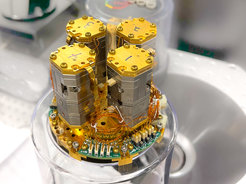Cold Spin-Electronics for Quantum Technologies
Launch of the project "CONDOR - Superconducting Spintronic Devices for Cryogenic Electronics"
The demand for electronics that operate at low temperatures is growing and becoming ever more important, especially for applications in the field of quantum computing technologies. This is the focus of the CONDOR project that was launched earlier this year. The Fraunhofer IPMS, Dresden and the Max Planck Institute for Microstructure Physics, Halle, are collaborating on innovative spin-based memory and logic components that operate at low temperatures.

Electronics that operate at low temperatures are commonly referred to as cryogenic electronics. Their importance has increased significantly in recent years due to the interest in the development of quantum computing technologies that go beyond CMOS, as well as for use in other domains, such as space. In quantum technologies it is often necessary to cool the quantum bits, the qubits, to cryogenic temperatures in order to extend the time over which they can operate. Therefore, it is essential to develop electronic components that can operate at the same low temperatures to guarantee the proper performance of future quantum computing systems.
The Fraunhofer Institute for Photonic Microsystems IPMS in Dresden and the Max Planck Institute of Microstructure Physics (MSP) in Halle have been working together since the beginning of this year on the project "CONDOR - Superconducting spintronic devices for cryogenic electronics". The cooperation program combines the excellent materials and device expertise and deep understanding of spin-based phenomena in Prof. Stuart Parkin's group at the Max Planck Institute of Microstructure Physics with the application-oriented research and infrastructure capabilities of the Fraunhofer IPMS. The novel cryogenic components to be developed in the three-year project will enable low-energy superconducting electronics for stand-alone superconducting computer systems as well as for integration with emerging quantum computer systems.

Prof. Dr. Stuart Parkin of the Max Planck Institute says: "CONDOR combines the expertise in spintronic and superconducting materials and devices at the Institute of Microstructure Physics, with the logic, memory and 300 mm wafer-scale integration expertise at Fraunhofer IPMS." Dr. Benjamin Lilienthal-Uhlig of Fraunhofer IPMS adds: "The Fraunhofer IPMS and the Max Planck Institute for Microstructure Physics have already successfully collaborated on the RASCAL project, where novel spintronic memory devices operating at room temperature were developed. These results form an important part of the CONDOR project."

The CONDOR project aims to develop a novel superconducting switch that can be used in cryogenic logic and memory devices. The switch is formed from a narrow superconducting wire to which a gate voltage is applied. The project will first unravel the origin of the suppression of superconductivity in such nanowires by the gate voltage and, thereby, develop superconducting field-effect transistors in both lateral and vertical geometries that operate at CMOS-compatible voltages. Finally, these cryogenic transistors will be used both as logic elements and as switches for accessing magnetic memory elements to enable cryogenic non-volatile memories with low power consumption. The memory devices are magnetic tunnel junctions specially designed to operate at low temperatures. These novel cryogenic logic and memory devices will thereby enable cryogenic electronic chips using superconducting materials and phenomena.
The final goal of the project is the realization of components based on low-energy superconducting electronics that can be used, at wafer scale, for autonomous superconducting computing systems, as well as for emerging quantum computing systems.
About the Fraunhofer IPMS
Fraunhofer IPMS is one of the leading international research and development service providers for electronic and photonic microsystems in the application fields of intelligent industrial solutions and manufacturing, medical technology and health, and mobility. In two state-of-the-art clean rooms and with a total of four development sites in Dresden, Cottbus and Erfurt, the institute develops innovative MEMS components and microelectronic devices on 200 mm and 300 mm wafers. Services range from consulting and process development to pilot production. With the Center Nanoelectronic Technologies (CNT), the Fraunhofer IPMS offers applied research on 300 mm wafers for microchip producers, suppliers, device manufacturers and R&D partners.
About the Max Planck Institute of Microstructure Physics
CONDOR is based within the NISE (Nanosystems from Ions, Electrons and Spins) department. NISE has substantial experimental research programs that are focused on novel atomically-engineered materials with useful functionalities. Of particular interest are spintronic materials and devices, superconductors, topological metals and insulators, proximity induced phenomena, and superconducting spintronics as well as beyond CMOS computing devices and systems especially for neuromorphic and quantum computing technologies. NISE is involved in numerous collaborative research projects with academic and industry partners from Germany and around the world (including Europe, North America, and Asia). The department has state-of-the-art experimental capabilities including a modern clean-room, aberration-corrected transmission electron microscopy, a super-resolution 3D printer for complex 3D nano-structures, and a wide range of measurement tools for optical, magnetic and transport properties for temperatures from above room temperature down to milli-kelvin temperatures.














